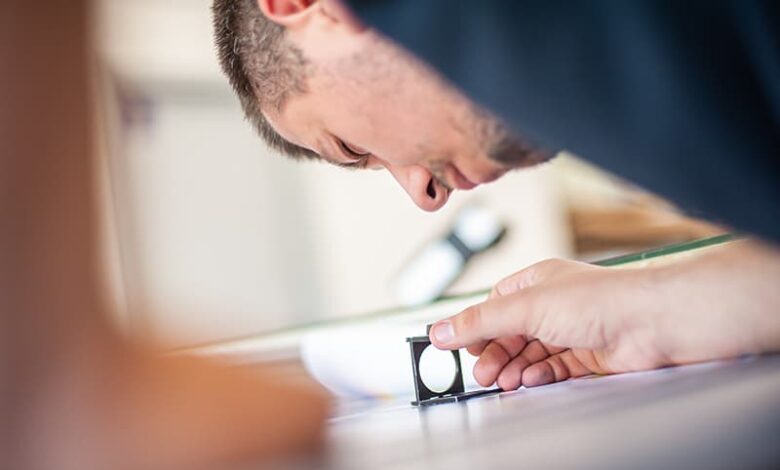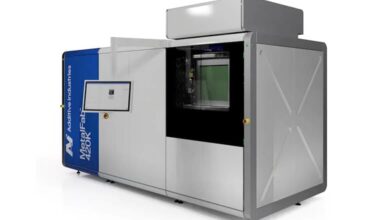
Pre-press output is an essential part of the printing industry, serving as the bridge between digital design and physical production. It converts digital design files and manufacturing specifications into the physical components required for label and packaging production. These components include critical items like printing plates, cylinders, films, and other tools used for the embellishment and finishing processes.
Overview of Pre-Press Procedures
At this stage of production, pre-press procedures involve multiple steps designed to ensure accuracy and efficiency. These include:
- Creating Layouts: Designing how images will be arranged on the printing material to maximize efficiency and minimize waste.
- Step-and-Repeat Application: Using a system to repeat the same label or image multiple times across the width and length of the printing substrate to optimize production speed.
- Film Imaging: If applicable, films are created for use in traditional plate-making processes.
- Printing Plate Preparation: This step involves imaging the plate, preparing it for installation into the printing press, and checking its accuracy.
Additionally, pre-press output includes mounting the printing plate accurately on the cylinder, assembling the necessary tools, and checking ancillary equipment. These steps ensure high-quality printing and embellishments, reducing downtime due to errors in setup.

Key Elements in Pre-Press
The following are the key components that ensure a seamless transition from design to print:
- Accurate Technical and Manufacturing Specifications: Having a well-documented and agreed-upon specification helps avoid errors during the transition from design to production.
- Accurate Layouts for Step-and-Repeat: This ensures that the job can be printed efficiently, with minimal material waste and optimized press time.
- Film Imaging: In some cases, films are imaged to transfer the design onto the plate. Films should be accurate and of high quality to ensure proper transfer onto the plate.
- Conventional Plate Imaging: Depending on the printing process (e.g., lithography, flexography, screen printing, gravure), plates are imaged either conventionally (film-based) or digitally through Computer-to-Plate (CtP) technology.
- Inks and Ink Matching: Correctly matched inks, as well as ink draw-downs (test samples), are essential to achieve consistent color across print runs.
- Print Cylinder Specifications: Each print cylinder must be tailored to the job at hand, including dimensions and specific requirements for the printing process.
- Tooling Data: Tooling used for embellishment and finishing must be prepared and checked to match the print job.
Common Pre-Press Challenges
Maintaining consistency during the pre-press stage is critical for efficient production. Common issues that can arise include:
- Deviation from Manufacturing Specifications: Changes to specifications can cause production delays and errors.
- Use of Unapproved Suppliers: Materials or suppliers not initially approved can affect color accuracy and overall print quality.
- Image Integrity and Repro Changes: Any changes to the image or reprographics process must be carefully managed to ensure consistency across print runs.
- Incorrect Die-Cutting Profiles: Die-cutting templates must be checked against the specifications to avoid misaligned or poorly cut labels.
- Changes in Print Process: If the print method is changed during production, files need to be adjusted to suit the new process.
- Substrate Variability: Different substrate types (e.g., paper, plastic) have unique characteristics that can affect print quality, ink absorption, and color accuracy.
Dot Gain and Pre-Press Modifications
Before the printing plate is imaged, adjustments may need to be made to the digital files to account for dot gain—an increase in the size of printed dots during the printing process. This phenomenon can cause colors to appear darker or less sharp. Feedback from press fingerprinting (a testing process used to calibrate the press) helps pre-press teams modify digital files to compensate for these variances.
Different printing processes have distinct dot gain tendencies. For instance:
- Flexographic printing tends to have more noticeable dot gain due to the softer plates and substrates used.
- Offset lithography may exhibit less dot gain, but adjustments are still needed to optimize ink trapping and color consistency.
By analyzing the press’s natural operating conditions, adjustments can be made to achieve the desired print quality. These compensations ensure that printed output closely matches the original design intent.
Pre-Press Layouts (Imposition) and Step-and-Repeat
Imposition (or print layout) is one of the critical stages in pre-press. The goal is to arrange multiple copies of the design on the printing substrate to minimize waste and maximize production yield. By optimizing the layout, printers can:
- Increase the number of impressions per cylinder revolution, reducing press time and material costs.
- Ensure the design fits within the operational parameters of the press and finishing equipment.
The step-and-repeat process further enhances production efficiency by enabling multiple labels or images to be printed at once. For example, a layout may allow for seven labels to be printed around the cylinder circumference and five labels across the width of the substrate. This results in 35 labels being printed in one revolution, which significantly speeds up production.
Imaging the Printing Plate
The printing plate is the core component in most printing processes. There are two primary methods of imaging plates:
- Film-Based Imaging: A traditional method where an imaged film is placed in contact with the plate and exposed to light to transfer the design.
- Computer-to-Plate (CtP): A digital process where the design is directly imaged onto the plate using a laser. CtP eliminates many steps involved in film-based imaging, improves precision, and reduces distortion, making it a preferred choice for modern printing operations.
CtP is used across various printing processes, including:
- Lithography: CtP technology provides fast, accurate imaging for lithographic plates.
- Flexography: Direct imaging on flexo plates enhances quality and allows for finer detail compared to traditional film-based methods.
- Gravure: Digital engraving of gravure cylinders ensures consistency, especially when multiple cylinders are required for the same job.
Flexography and Letterpress Plates
For flexographic printing, plates are typically made from photopolymer materials. These plates are exposed to UV light to harden the image areas while the non-image areas are washed away. Sleeve-based systems are also available for flexo printing, which eliminates the need for plate mounting and allows for quicker changeovers in mid and wide-web presses.
In letterpress printing, plates are usually photopolymer on a metal or polyester base. This plate-making process is relatively quick, with plates ready for press within one to two hours. However, precise exposure and wash-out procedures must be followed to maintain print quality.
Offset Lithography and Screen Printing
Offset lithography uses flat, planographic plates, typically coated with a photosensitive emulsion. CtP is widely used in lithography, allowing for direct imaging onto plates without the need for films. This increases efficiency and accuracy while reducing production time.
Screen printing uses a mesh screen coated with a photosensitive emulsion. The image is exposed on the screen, and the emulsion is washed out in the image areas, allowing ink to pass through and transfer the design onto the substrate.
Gravure Cylinder Imaging
Gravure cylinders are engraved with tiny cells that vary in depth and size to control the amount of ink transferred. Today, these cylinders are typically engraved using digital lasers, which ensures high precision and repeatability. This digital process eliminates the inconsistencies of traditional chemical etching.
Press Setup Considerations
Proper press setup is essential to achieving consistent, high-quality print output. This involves:
- Inking Systems: Adjusting the volume of ink applied to the plate, substrate, or cylinder to achieve the correct color strength.
- Plate Mounting: Ensuring plates are mounted with precise alignment, avoiding errors such as image distortion or misregistration.
- Cylinder Maintenance: Regular checks of print cylinders, gears, and bearings are necessary to maintain even contact and prevent issues like cylinder wear or misalignment.
Summary of Pre-Press Operations
The pre-press stage is vital for ensuring that all aspects of the print job are prepared accurately. From creating layouts to imaging plates and mounting tools, careful attention to detail at every step guarantees that the final print is of the highest quality. Proper management of pre-press elements, such as dot gain compensation, tooling data, and substrate characteristics, ensures efficient job turnaround and reduces the risk of production errors or delays.





